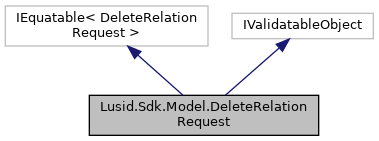DeleteRelationRequest
More...
|
| Dictionary< string, string > | SourceEntityId [get, set] |
| | The identifier of the source entity of the relation to be deleted. More...
|
| |
| Dictionary< string, string > | TargetEntityId [get, set] |
| | The identifier of the target entity of the relation to be deleted. More...
|
| |
◆ DeleteRelationRequest() [1/2]
| Lusid.Sdk.Model.DeleteRelationRequest.DeleteRelationRequest |
( |
| ) |
|
|
inlineprotected |
◆ DeleteRelationRequest() [2/2]
| Lusid.Sdk.Model.DeleteRelationRequest.DeleteRelationRequest |
( |
Dictionary< string, string > |
sourceEntityId = default(Dictionary<string, string>), |
|
|
Dictionary< string, string > |
targetEntityId = default(Dictionary<string, string>) |
|
) |
| |
|
inline |
Initializes a new instance of the DeleteRelationRequest class.
- Parameters
-
| sourceEntityId | The identifier of the source entity of the relation to be deleted. (required). |
| targetEntityId | The identifier of the target entity of the relation to be deleted. (required). |
◆ Equals() [1/2]
◆ Equals() [2/2]
| override bool Lusid.Sdk.Model.DeleteRelationRequest.Equals |
( |
object |
input | ) |
|
|
inline |
Returns true if objects are equal
- Parameters
-
| input | Object to be compared |
- Returns
- Boolean
◆ GetHashCode()
| override int Lusid.Sdk.Model.DeleteRelationRequest.GetHashCode |
( |
| ) |
|
|
inline |
Gets the hash code
- Returns
- Hash code
◆ ToJson()
| virtual string Lusid.Sdk.Model.DeleteRelationRequest.ToJson |
( |
| ) |
|
|
inlinevirtual |
Returns the JSON string presentation of the object
- Returns
- JSON string presentation of the object
◆ ToString()
| override string Lusid.Sdk.Model.DeleteRelationRequest.ToString |
( |
| ) |
|
|
inline |
Returns the string presentation of the object
- Returns
- String presentation of the object
◆ SourceEntityId
| Dictionary<string, string> Lusid.Sdk.Model.DeleteRelationRequest.SourceEntityId |
|
getset |
The identifier of the source entity of the relation to be deleted.
The identifier of the source entity of the relation to be deleted.
◆ TargetEntityId
| Dictionary<string, string> Lusid.Sdk.Model.DeleteRelationRequest.TargetEntityId |
|
getset |
The identifier of the target entity of the relation to be deleted.
The identifier of the target entity of the relation to be deleted.
The documentation for this class was generated from the following file:
- /home/docs/checkouts/readthedocs.org/user_builds/lusid-sdk-csharp/checkouts/latest/sdk/Lusid.Sdk/Model/DeleteRelationRequest.cs
